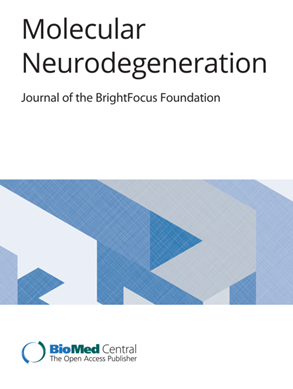ASO-mediated knock-down of GPNMB in mutant-GRN and in Grn-deficient peripheral myeloid cells disrupts lysosomal function and immune responses
IF 14.9
1区 医学
Q1 NEUROSCIENCES
引用次数: 0
Abstract
GPNMB has been discussed as a potential therapeutic target in GRN-mediated neurodegeneration, based on the observed reproducible upregulation in FTD-GRN cerebrospinal fluid (CSF) and post-mortem brain. However, the functional impacts of up-regulated GPNMB are currently unknown, and it is currently unclear if targeting GPNMB will be protective or deleterious. Increases in GPNMB seen in FTD-GRN are reproduced in brains of aged Grn-deficient mice. Importantly, although brains of young Grn-deficient mice do not exhibit upregulated Gpnmb expression, peripheral immune cells of these mice exhibit increased Gpnmb expression as young as 5-to-6 months, suggesting the effects of Grn-deficiency in the periphery proceed those in the brain. Grn-deficiency is known to alter peripheral immune cell function, including impaired autophagy and altered cytokine secretion. GPNMB has potential effects on these processes, but has never been studied in peripheral immune cells of patients or preclinical models. Informing the functional significance of GPNMB upregulation in Grn-deficient states in myeloid cells has potential to inform GPNMB as a therapeutic candidate. The effects of GPNMB knock-down via antisense oligonucleotide (ASO) were assessed in peripheral blood mononuclear cells (PBMCs) from 25 neurologically healthy controls (NHCs) and age- and sex-matched FTD-GRN patients, as well as peritoneal macrophages (pMacs) from progranulin-deficient (Grn -/-) and B6 mice. Lysosomal function, antigen presentation and MHC-II processing and recycling were assessed, as well as cytokine release and transcription. ASO-mediated knock-down of GPNMB increased lysosomal burden and IL1β cytokine secretion in FTD-GRN carriers and NHCs monocytes. ASO-mediated knock-down of Gpnmb in Grn-deficient macrophages decreased lysosomal pan-cathepsin activity and protein degradation. In addition, ASO-mediated knock-down of Gpnmb increased MHC-II surface expression, which was driven by decreased MHC-II uptake and recycling, in macrophages from Grn-deficient females. Finally, ASO-mediated knock-down of Gpnmb dysregulated IFN $$\gamma$$ -stimulated IL6 cytokine transcription and secretion by mouse macrophages due to the absence of regulatory actions of the Gpnmb extracellular fragment (ECF). Our data herein reveal that GPNMB has a regulatory effect on multiple immune effector functions, including capping inflammation and immune responses in myeloid cells, potentially via secretion of its ECF. Therefore, in progranulin-deficient states, the marked upregulation in GPNMB transcript and protein may represent a compensatory mechanism to preserve lysosomal function in myeloid cells. These novel findings indicate that targeted depletion of GPNMB in FTD-GRN would not be a rational therapeutic strategy because it is likely to dysregulate important immune cell effector functions mediated by GPNMB. Specifically, our data indicate that therapeutic strategies inhibiting GPNMB levels and/or activity may worsen the effects of GRN deficiency.在突变体-GRN和缺失Grn的外周髓系细胞中,ASO介导的GPNMB基因敲除会破坏溶酶体功能和免疫反应
GPNMB被认为是grn介导的神经退行性疾病的潜在治疗靶点,这是基于FTD-GRN脑脊液(CSF)和死后脑中观察到的可重复上调。然而,上调GPNMB的功能影响目前尚不清楚,目前尚不清楚靶向GPNMB是保护还是有害。FTD-GRN中GPNMB的增加在老年grn缺陷小鼠的大脑中重现。重要的是,尽管年轻的grn缺陷小鼠的大脑不表现出上调的Gpnmb表达,但这些小鼠的外周免疫细胞在5- 6个月时表现出Gpnmb表达的增加,这表明外周grn缺陷的影响持续于大脑。已知grn缺乏会改变外周免疫细胞功能,包括自噬受损和细胞因子分泌改变。GPNMB对这些过程有潜在的影响,但从未在患者的外周免疫细胞或临床前模型中进行过研究。了解GPNMB在髓细胞grn缺乏状态下上调的功能意义,有可能为GPNMB作为一种候选治疗药物提供信息。通过反义寡核苷酸(ASO)敲除GPNMB在25例神经健康对照(NHCs)和年龄和性别匹配的FTD-GRN患者的外周血单个核细胞(PBMCs)以及来自前颗粒蛋白缺陷(Grn -/-)和B6小鼠的腹膜巨噬细胞(pMacs)中的作用进行了评估。评估溶酶体功能、抗原呈递、MHC-II加工和再循环,以及细胞因子释放和转录。aso介导的GPNMB敲除增加FTD-GRN携带者和NHCs单核细胞的溶酶体负荷和il - 1β细胞因子分泌。aso介导的grn缺陷巨噬细胞中Gpnmb的敲除降低了溶酶体泛组织蛋白酶活性和蛋白质降解。此外,aso介导的Gpnmb敲除增加了grn缺陷雌性巨噬细胞中MHC-II表面表达,这是由MHC-II摄取和再循环减少所驱动的。最后,由于Gpnmb细胞外片段(ECF)的调节作用缺失,aso介导的Gpnmb敲除会失调IFN $$\gamma$$ -刺激小鼠巨噬细胞的IL6细胞因子转录和分泌。我们在此的数据显示,GPNMB对多种免疫效应功能具有调节作用,包括抑制髓细胞中的炎症和免疫反应,可能通过其ECF的分泌。因此,在颗粒蛋白前缺失状态下,GPNMB转录物和蛋白的显著上调可能代表了髓细胞中保留溶酶体功能的代偿机制。这些新发现表明,靶向清除FTD-GRN中的GPNMB可能不是一种合理的治疗策略,因为它可能会失调GPNMB介导的重要免疫细胞效应功能。具体来说,我们的数据表明,抑制GPNMB水平和/或活性的治疗策略可能会加重GRN缺乏的影响。
本文章由计算机程序翻译,如有差异,请以英文原文为准。
求助全文
约1分钟内获得全文
求助全文
来源期刊

Molecular Neurodegeneration
医学-神经科学
CiteScore
23.00
自引率
4.60%
发文量
78
审稿时长
6-12 weeks
期刊介绍:
Molecular Neurodegeneration, an open-access, peer-reviewed journal, comprehensively covers neurodegeneration research at the molecular and cellular levels.
Neurodegenerative diseases, such as Alzheimer's, Parkinson's, Huntington's, and prion diseases, fall under its purview. These disorders, often linked to advanced aging and characterized by varying degrees of dementia, pose a significant public health concern with the growing aging population. Recent strides in understanding the molecular and cellular mechanisms of these neurodegenerative disorders offer valuable insights into their pathogenesis.
 求助内容:
求助内容: 应助结果提醒方式:
应助结果提醒方式:


